Mattel Bundle
How Does Mattel Thrive in the Toy Industry?
Mattel, a global leader in the toy industry, continues to captivate audiences worldwide with its iconic brands and innovative products. With a history spanning decades, the Mattel SWOT Analysis reveals the company's strengths, weaknesses, opportunities, and threats. Its enduring influence is evident in its robust financial performance and strategic adaptation to evolving consumer preferences and technological advancements.
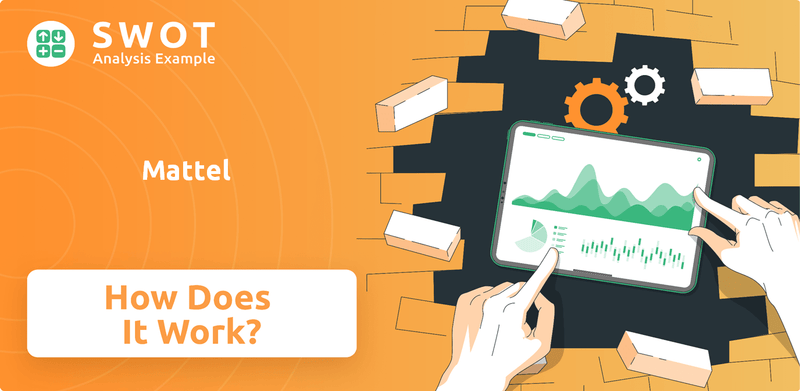
Understanding the Mattel business model is essential for investors, consumers, and industry observers. From its popular toy brands like Barbie and Hot Wheels to its content creation and immersive experiences, Mattel's integrated approach reinforces brand loyalty and opens new avenues for monetization. This in-depth examination will explore how the Mattel Company operates and generates profit, illuminating the strategies that maintain its market leadership in the competitive toy manufacturer landscape.
What Are the Key Operations Driving Mattel’s Success?
The Mattel Company operates by designing, manufacturing, and distributing toys and consumer products worldwide. It focuses on creating play experiences for children and families. Mattel's core business revolves around iconic brands such as Barbie, Hot Wheels, Fisher-Price, and MEGA, alongside content and experiences built around these properties. The Mattel business model is centered on a global operational framework.
Mattel's operational processes include extensive research and development for new product innovation, global sourcing of materials, and advanced manufacturing capabilities. The company uses both in-house facilities and third-party partners. It also has sophisticated logistics for worldwide distribution. Mattel uses a multi-channel sales approach to reach consumers.
Mattel's value proposition lies in its ability to create high-quality, engaging toys that foster creativity. It also offers globally recognized brands that evoke nostalgia and trust across generations. This approach has allowed Mattel to maintain a strong position in the competitive toy industry. For more information, check out the Target Market of Mattel.
Mattel's main products include dolls (Barbie), vehicles (Hot Wheels), infant and preschool toys (Fisher-Price), and construction sets (MEGA). These products are designed to appeal to a wide range of ages and interests, ensuring a broad market reach. The company also develops content and experiences related to its intellectual properties.
Mattel operates manufacturing facilities globally, including in North America, Europe, and Asia. The company uses a multi-channel sales approach, distributing products through mass merchandisers, toy specialty stores, e-commerce platforms, and direct-to-consumer channels. Strategic partnerships are vital for expanding reach and co-creating branded content.
Mattel's supply chain is a crucial part of its operations, integrating manufacturing facilities across various regions. The company focuses on efficiency and responsiveness to market demand. This allows Mattel to quickly adapt to changing consumer preferences and maintain a competitive edge in the toy industry.
Mattel distributes its products through mass merchandisers, toy specialty stores, e-commerce platforms, and its own direct-to-consumer channels. Strategic partnerships with retailers and entertainment companies are vital for expanding reach and co-creating branded content. The company's diverse distribution channels ensure that its products are accessible to a wide audience.
Mattel's success is based on understanding play patterns and child development, coupled with innovation in product design and brand storytelling. This approach allows the company to create products that resonate with children and families worldwide. The company's focus on innovation and brand building helps it to maintain its market position.
- Global Reach: Mattel operates globally, with products sold in over 150 countries.
- Brand Portfolio: The company's portfolio includes iconic brands like Barbie, Hot Wheels, and Fisher-Price.
- Innovation: Mattel invests heavily in research and development to create new and engaging products.
- Sustainability: Mattel is committed to sustainability, with initiatives to reduce its environmental impact.
Mattel SWOT Analysis
- Complete SWOT Breakdown
- Fully Customizable
- Editable in Excel & Word
- Professional Formatting
- Investor-Ready Format
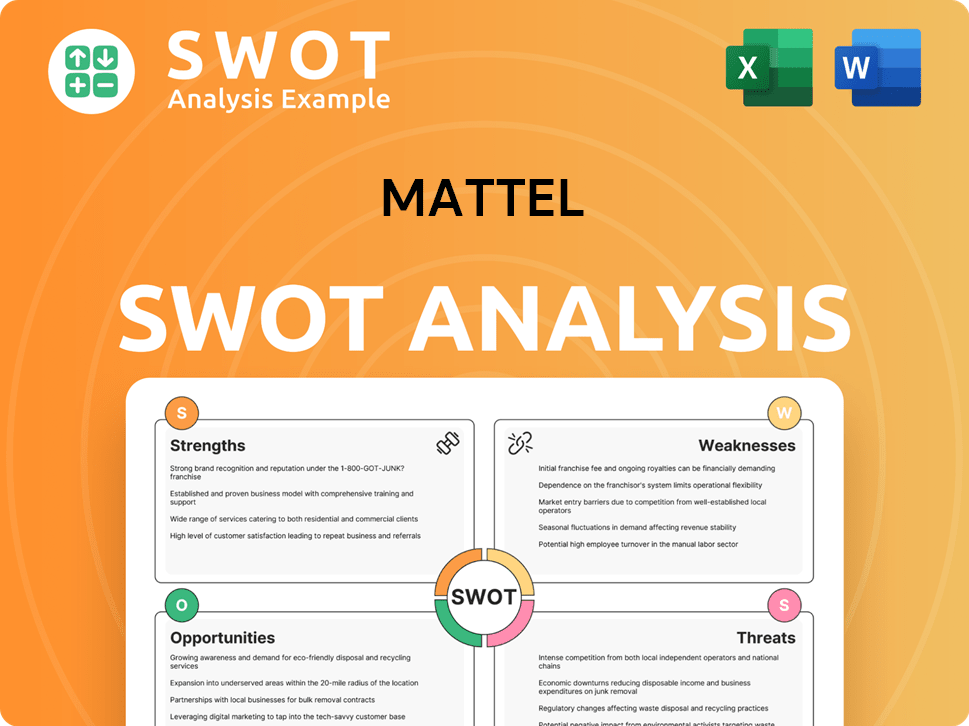
How Does Mattel Make Money?
The Mattel Company generates revenue primarily through the sale of toys and consumer products. The Mattel business model focuses on a diverse portfolio of brands, including iconic names like Barbie and Hot Wheels. This approach allows the company to capture a broad market share within the toy industry.
Revenue streams are categorized by product segments: Dolls, Vehicles, Infant and Preschool, and Action Figures, Building Sets, Games, and Other. Mattel also utilizes various monetization strategies beyond direct product sales, such as licensing and content creation.
In 2023, Dolls accounted for $1.64 billion in net sales, Vehicles for $1.52 billion, and Infant and Preschool for $930.5 million. The 'Action Figures, Building Sets, Games, and Other' category contributed $1.35 billion to net sales. The success of the Barbie movie in 2023 significantly boosted brand relevance and demonstrated the immense value of its licensing and content creation strategies.
Beyond direct sales, Mattel leverages several strategies to generate revenue. These include licensing its intellectual property and direct-to-consumer sales through e-commerce platforms. The company continuously explores new avenues to diversify its income streams.
- Licensing: Mattel licenses its intellectual property for use in other consumer products, entertainment content (films, television series, digital games), and experiences.
- Entertainment: The success of the Barbie movie in 2023 highlighted the value of content creation.
- Direct-to-Consumer Sales: E-commerce platforms allow for higher margins and direct engagement with the customer base.
- Digital Integrations and Experiential Offerings: Mattel explores new revenue avenues to capitalize on evolving consumer trends.
For a deeper dive into Mattel's strategic growth, consider reading about the Growth Strategy of Mattel.
Mattel PESTLE Analysis
- Covers All 6 PESTLE Categories
- No Research Needed – Save Hours of Work
- Built by Experts, Trusted by Consultants
- Instant Download, Ready to Use
- 100% Editable, Fully Customizable
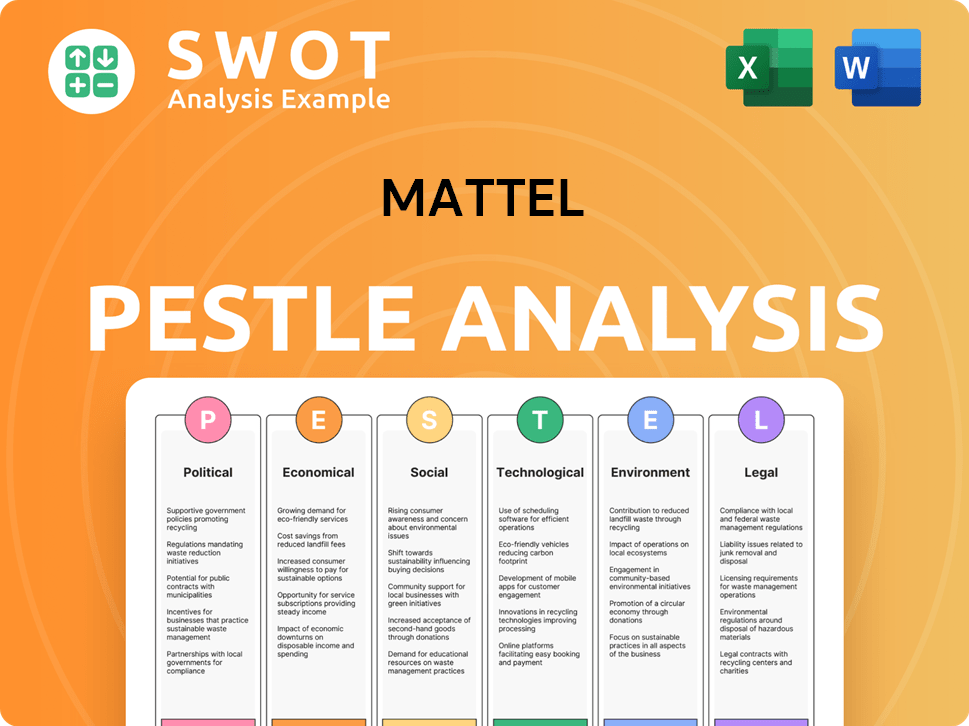
Which Strategic Decisions Have Shaped Mattel’s Business Model?
The Mattel Company has a rich history, marked by significant milestones and strategic shifts that have shaped its position in the toy industry. From the introduction of iconic brands like Barbie and Hot Wheels to strategic acquisitions and adaptations to changing consumer preferences, Mattel has consistently evolved. The company's ability to innovate, leverage its intellectual property, and navigate market dynamics has been crucial to its longevity and success. For a deeper dive into the company's origins, you can read a Brief History of Mattel.
Mattel's business model is built on a foundation of strong brand recognition, efficient manufacturing, and extensive distribution networks. The company's success is also tied to its ability to adapt to market trends, including the rise of digital entertainment and evolving consumer preferences. The recent success of the Barbie movie underscores Mattel's capacity to extend its brands beyond traditional toy sales and create new revenue streams through content and licensing.
Mattel's competitive edge stems from its portfolio of globally recognized brands, economies of scale, and ability to innovate. The company faces challenges, including supply chain disruptions and shifts in consumer behavior. Despite these hurdles, Mattel continues to invest in digital transformation, optimize its operations, and diversify its offerings to maintain its market position and drive future growth. The company's strategic moves and brand strength have been key to its resilience and continued relevance in the competitive toy industry.
The launch of Barbie in 1959 was a pivotal moment, establishing a cultural icon and a cornerstone of Mattel's brand portfolio. The acquisition of Fisher-Price in 1993 solidified its position in the infant and preschool segment. The introduction of Hot Wheels in 1968 created a lasting legacy in the vehicle toy category.
Mattel has focused on digital transformation, optimizing manufacturing and distribution, and diversifying its product offerings. The company has also leveraged its intellectual property through content creation, as seen with the success of the Barbie movie in 2023. These moves have aimed to enhance its market position and adapt to evolving consumer preferences.
Mattel's competitive advantages include unparalleled brand strength, economies of scale in manufacturing, and an extensive global reach. The company's ability to innovate and adapt to market trends, along with effective marketing strategies, sustains its business model. These factors contribute to Mattel's ability to maintain its competitive edge in the toy industry.
In 2023, Mattel reported net sales of approximately $5.44 billion, demonstrating the company's robust performance. The success of the Barbie movie significantly boosted the company's revenue and brand recognition. Mattel's financial results reflect its strategic initiatives and the strength of its brand portfolio.
Mattel's marketing strategies have been crucial in maintaining brand relevance and consumer engagement. The company's distribution network plays a vital role in reaching global markets and ensuring product availability. Mattel's ability to innovate and adapt to new trends has sustained its business model.
- Brand Building: Leveraging iconic brands like Barbie and Hot Wheels.
- Digital Transformation: Investing in digital content and tech-integrated toys.
- Market Expansion: Targeting diverse markets through extensive global reach.
- Operational Efficiency: Optimizing manufacturing and distribution networks.
Mattel Business Model Canvas
- Complete 9-Block Business Model Canvas
- Effortlessly Communicate Your Business Strategy
- Investor-Ready BMC Format
- 100% Editable and Customizable
- Clear and Structured Layout
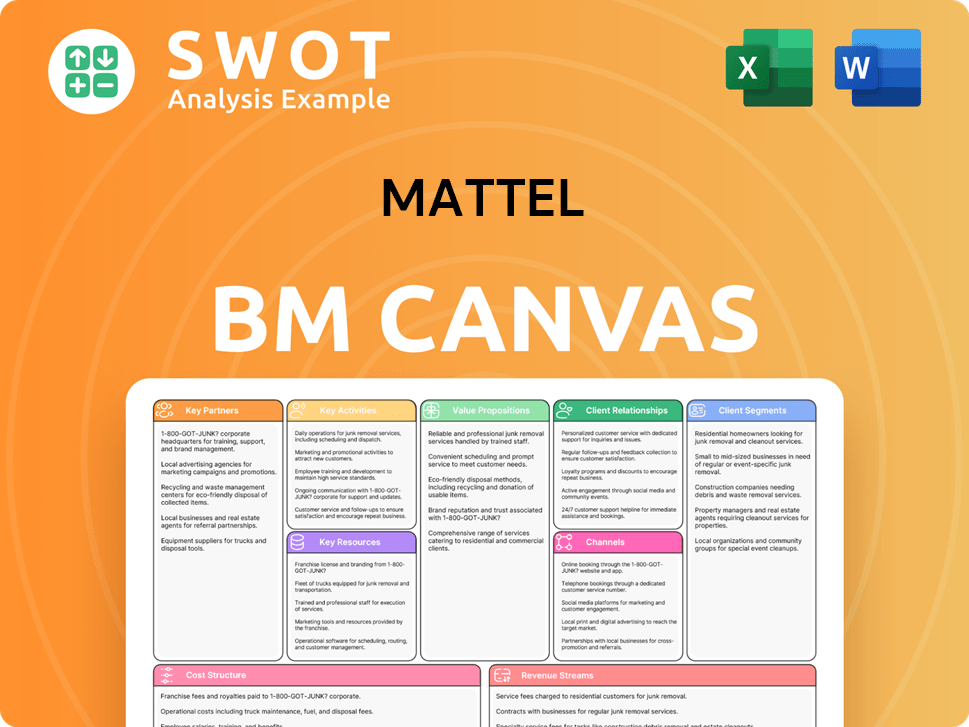
How Is Mattel Positioning Itself for Continued Success?
The Mattel Company holds a prominent position in the global toy industry, competing directly with major players like Hasbro and LEGO. Its market share is significant, particularly in key categories such as dolls and vehicles. The company's brands are widely recognized and enjoy strong customer loyalty, supported by an extensive distribution network. This strong brand equity provides a solid competitive advantage, making it a formidable player in the toy industry.
However, Mattel faces several key risks. These include the cyclical nature of the toy market, changing consumer preferences (with a shift towards digital entertainment), and intense competition. Additionally, the company must navigate potential supply chain disruptions and the impact of global economic conditions on consumer spending. Regulatory changes related to product safety and environmental standards also pose ongoing challenges. For more insights, consider reading about the Competitors Landscape of Mattel.
Mattel is a leading toy manufacturer with a substantial global market share. Its portfolio includes iconic brands like Barbie, Hot Wheels, and Fisher-Price. These brands contribute significantly to its revenue and brand recognition. The company's extensive distribution network ensures its products are available worldwide.
Key risks include shifts in consumer preferences towards digital entertainment and intense competition within the toy market. Supply chain disruptions and global economic conditions also pose challenges. The company must also comply with evolving product safety regulations and environmental standards.
Mattel is focused on strengthening its core brands and expanding its digital footprint. It is exploring new product categories and partnerships. The success of the Barbie movie signals a strategic move towards becoming a more comprehensive entertainment company.
Mattel is investing in brand building, product innovation, and expanding into emerging markets. The company aims to leverage its intellectual property across diverse entertainment platforms. This includes cinematic adaptations and digital content, aiming to solidify its position as a global leader in play and entertainment.
Mattel is executing several strategic initiatives to ensure future growth and maintain its market position. These strategies involve a multi-faceted approach to adapt to the evolving market dynamics and consumer preferences.
- Focus on Core Brands: Strengthening iconic brands like Barbie and Hot Wheels through product innovation and marketing.
- Digital Expansion: Enhancing its digital presence through online content, gaming, and e-commerce platforms.
- Licensing and Partnerships: Leveraging intellectual property through licensing agreements and collaborations.
- Geographic Expansion: Targeting emerging markets to increase its global reach and market share.
Mattel Porter's Five Forces Analysis
- Covers All 5 Competitive Forces in Detail
- Structured for Consultants, Students, and Founders
- 100% Editable in Microsoft Word & Excel
- Instant Digital Download – Use Immediately
- Compatible with Mac & PC – Fully Unlocked
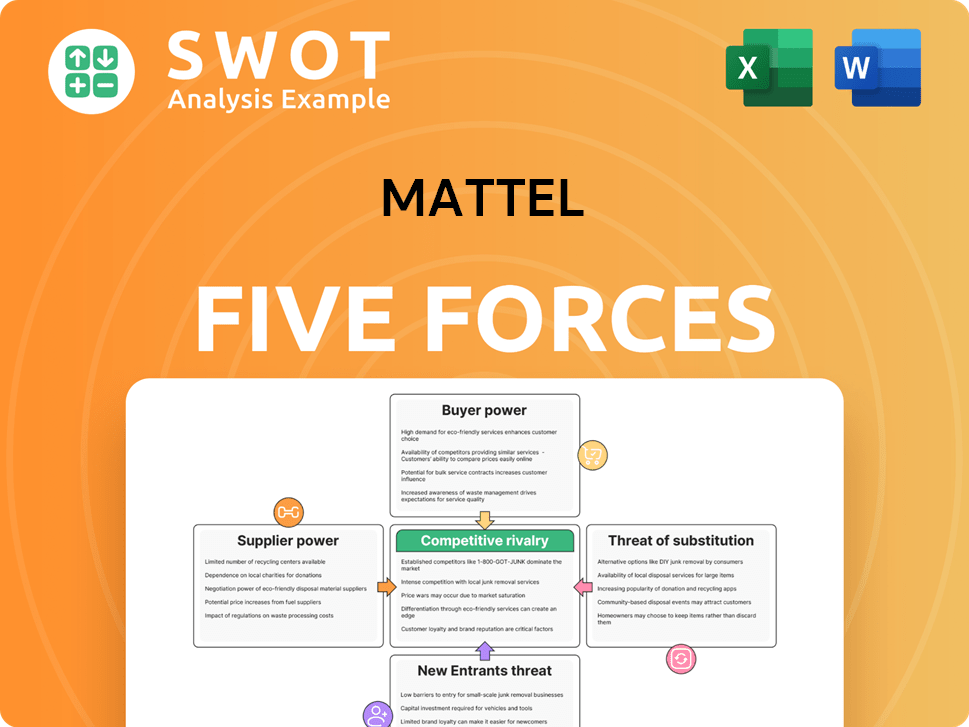
Related Blogs
- What are Mission Vision & Core Values of Mattel Company?
- What is Competitive Landscape of Mattel Company?
- What is Growth Strategy and Future Prospects of Mattel Company?
- What is Sales and Marketing Strategy of Mattel Company?
- What is Brief History of Mattel Company?
- Who Owns Mattel Company?
- What is Customer Demographics and Target Market of Mattel Company?
Disclaimer
All information, articles, and product details provided on this website are for general informational and educational purposes only. We do not claim any ownership over, nor do we intend to infringe upon, any trademarks, copyrights, logos, brand names, or other intellectual property mentioned or depicted on this site. Such intellectual property remains the property of its respective owners, and any references here are made solely for identification or informational purposes, without implying any affiliation, endorsement, or partnership.
We make no representations or warranties, express or implied, regarding the accuracy, completeness, or suitability of any content or products presented. Nothing on this website should be construed as legal, tax, investment, financial, medical, or other professional advice. In addition, no part of this site—including articles or product references—constitutes a solicitation, recommendation, endorsement, advertisement, or offer to buy or sell any securities, franchises, or other financial instruments, particularly in jurisdictions where such activity would be unlawful.
All content is of a general nature and may not address the specific circumstances of any individual or entity. It is not a substitute for professional advice or services. Any actions you take based on the information provided here are strictly at your own risk. You accept full responsibility for any decisions or outcomes arising from your use of this website and agree to release us from any liability in connection with your use of, or reliance upon, the content or products found herein.